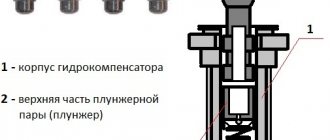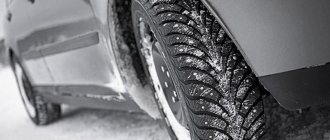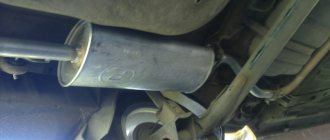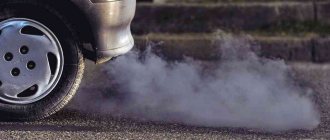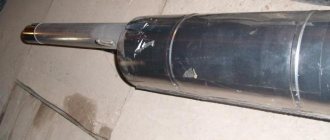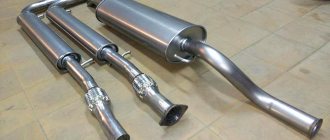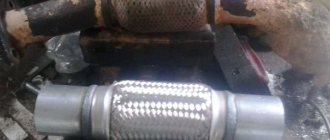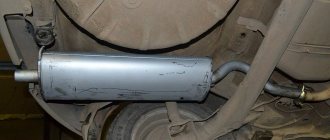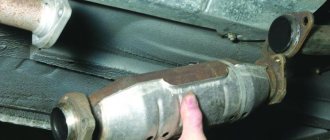- home
- Car muffler
- …
Not long ago I wrote an article about “SPIDER 4-2-1 and 4-1” , namely, why it is needed at all and whether it can add 10% power (it’s an interesting read). But in this article they started writing comments to me: - that I forgot to mention such an important thing as “thermal tape”, that with proper tuning it is necessary to wrap it around the muffler, in particular the exhaust manifold. So let's look at it - why this needs to be done and whether it really gives an increase in power of several “horses”...
As I wrote in that article - MIRACLES DO NOT HAPPEN, it is impossible to simply install a SPIDER and get an increase of as much as 10 horsepower! You need to completely re-equip the entire exhaust system, starting from the exhaust manifold , removing the catalyst , installing sports resonators, and even calculating a certain pipe diameter. Only then can you achieve power of + 10% of the nominal. BUT now another topic is starting to be discussed, that it is enough to wrap “thermal tape” on the improved SPIDER and then plus another 5%!!! Is it so?
How to wrap a muffler with thermal tape
If you decide that the benefits of thermal tape outweigh the possible negative consequences, follow these rules when wrapping:
- Wet the thermal tape thoroughly before starting work so that it is more securely attached to the metal;
- Wind evenly so that there is an equal number of layers of thermal tape throughout the entire exhaust manifold (or the entire muffler, depending on the chosen winding tactics);
- Use metal clamps to secure the ribbon through a certain number of skeins, this will allow the ribbon to hold tighter.
Remember that you perform any such experiments with a car that are not provided for in the operating instructions at your own peril and risk.
How to wrap a muffler yourself
The mechanics at the service station will undertake to wrap the car muffler, but for this simple procedure you will have to pay a lot of money. Thrifty drivers or tuning enthusiasts who prefer to improve their car with their own hands can easily use heat-resistant tape on their own. To do this you need:
- Purchase high-quality material (cheap no-name Chinese tapes are most often made without adherence to technology and may contain asbestos).
- Remove the muffler from the car, clean it of dirt and corrosion, and degrease it.
- To protect the exhaust system, you can paint the part with heat-resistant, corrosion-resistant paint before winding.
- To make the thermal tape fit better, you need to soften it with plain water, place it in a container with liquid for a couple of hours, and squeeze it thoroughly. It is recommended to wrap it while the tape is still wet - after drying, it will exactly take the given shape.
- When winding, each subsequent layer should overlap the bottom one by about half.
- The tape is fixed with ordinary steel clamps. Until all the work is completed, it is better not to tighten them completely - the winding may need to be adjusted.
- Having reached the end of the pipe, you should hide the tip of the tape under other layers so that it does not stick out.
The first connection may not work out very well, so it is better to start fastening with the second clamp, temporarily securing the outer part with tape. When you get comfortable with securely fastening the clamps, and if there is no need to correct the winding of the first node, you can remove the tape and correctly fasten the first clamp.
How to wrap a muffler
The thermal tape should wrap tightly around the muffler, but the bending parts or the junction of the resonator with the exhaust pipe are difficult to wrap alone. It is better to do this with an assistant who will hold the fabric in “difficult” places while you stretch and apply the tape.
If you have to work without an assistant, you can temporarily fix the bandage on the folds with ordinary tape, which must be removed after wrapping is completed.
Winding thermal tape increases the diameter of the pipe. Therefore, before finally tightening the clamps, you need to “try on” the part in place to make sure that it fits properly.
It should be borne in mind that you make any changes to the design of the car that are not provided by the manufacturer at your own peril and risk. Before starting work, think carefully about all the pros and cons of this solution.
After winding, you can be sure that the temperature of the car muffler while the engine is running will remain at a stable level, without causing excessive heating of the engine and without complicating the exit of exhaust gases.
How to wrap with your own hands quickly and without mistakes
A collector in a car is
an important rule - winding is dense and uniform in width. Pipes must be cleaned and degreased before treatment.
To perform quality work, adhere to some rules:
- individual circles need to be fixed with metal clamps, and at the end proceed in the same way;
- before winding, it is necessary to treat it with corrosion- and high-temperature-resistant paint;
- buy tape from well-known manufacturers, the options presented on ALI are of too low quality;
- the optimal width is 4-5 cm, narrower or wider types will be more difficult to wind;
- Before starting the main steps, soak the tape in water for 1-2 hours.
Usually only the exhaust manifold is wrapped, but if desired, the entire muffler can be treated.
Application technology
The technology of winding exhaust system elements does not contain secrets. The main task is to ensure density and uniformity of laying.
Experts advise carrying out preparatory work before using the material on the collector. They include treating the “spider” with heat-resistant paint or special anti-corrosion compounds.
To obtain a layer of thermal insulation:
- Make several turns;
- Fix the initial section with a metal clamp (wire);
- Winding continued with overlapping turns of 1/3-1/2 the width of the tape;
- After a certain distance, the layer is additionally fixed with clamps (on the collector, due to its short length, installing 1-2 intermediate ones is sufficient).
- The end of the strip is carefully masked and also secured with a clamp.
Winding is carried out with force, which allows you to achieve the required packing density. Experts recommend moistening the material (place it in a container filled with water for 30-60 minutes) before use. After drying, the tape shrinks and adheres tightly to the surfaces.
Video with installation instructions.
The positive aspects of processing exhaust system elements with tape are determined by solving the underlying problems. Among the disadvantages of using the material are:
- Pressure created by a significant volume of hot exhaust gases. The result is increased load on the valve mechanism.
- Maintaining high temperatures inside system elements, leading to accelerated wear.
- Deposition of dirt, aggressive chemicals, and moisture absorption on the surface of the material. Treated parts lose their appearance over time, and constant contact with contamination provokes the accelerated development of corrosion processes.
Quite a high cost of the material.
How to wind thermal tape?
Features of boring cylinder head channels with your own hands
After selecting the thermal tape, you need to wind it around the collector. First of all, degrease the surface of the collector and paint it with a layer of heat-resistant paint that will protect it from corrosion. While the paint is drying, soak the tape in water for 3 hours. This action will allow the tape to lie tighter and give it additional stretch. Then wrap the tape over the commutator in two layers.
Speaking of layers. Usually the tape is wound in one or two layers, but this does not prohibit making another layer, since the more layers, the better the thermal insulation properties. Therefore, the choice of layers is yours. However, two layers are the best option and are applicable in any case.
When winding, use only a single strip, as pieces of tape will only reduce its effectiveness.
Once the commutator is completely rewound, press the tape to it using a metal clamp. When fastening, it is also possible to use thick wire.
That's all. This completes the thermal insulation of the collector. As you can see, this is not a complicated process, however, it should be approached as responsibly as possible, since poorly wound tape usually does not last long.
Thermal tape to protect the car muffler from overheating
- Why do you need thermal tape for a muffler?
- Characteristics of thermal tape
- Which thermal tape to choose?
- Application technique
- Advantages and disadvantages of thermal tapes
- How to wind it yourself: instructions
- Recommendations
A caring car owner tries to improve his productivity and efficiency at work. One of the assistants in this matter is thermal tape for the muffler. This element can improve the power characteristics of the engine and change the sound of the exhaust.
This article is devoted to thermal tapes for car mufflers. It covers:
- reasons for its necessity;
- rules for applying tape;
- advantages and disadvantages;
- criteria for its selection;
- instructions on how to wrap the muffler yourself.
Why do you need to wrap?
What is a downpipe and why is it needed?
Those skeptics who doubt the ability of such thermal tape to increase engine power by several horsepower should give several of the most common arguments regarding what other significant advantages thermal tape provides for the muffler, and why it may be needed:
- This thermal tape helps eliminate the ringing, sometimes rattling sound in the muffler during the exhaust, which is observed quite often in practice. “Cushioning” is similar to how if a rubber lining was placed at the bottom of a metal dish - now when you throw a nut there, sound will be absorbed;
- Thermal tape helps reduce the temperature under the engine hood, which helps extend the life of many parts, primarily those made of plastic, as well as the car battery;
- The main advantage of thermal tape is increased motor power. It can be simply explained using physical laws. The fact is that the exhaust system, by its structure, contributes to the braking of exhaust gases. Therefore, the faster they are retracted, the easier it is for the engine to work, so that it does not spend additional significant effort “pushing” them through the muffler pipe. Having served their purpose, the gases enter the cold pipe of the exhaust manifold, immediately cooling and compressing, thereby reducing their exit speed. Thermal tape on the muffler prevents them from cooling quickly, that is, it becomes a constant assistant to the engine. Due to the fact that he does not have to spend extra effort on running them, the efficiency of the motor power increases, and this is the main argument in favor of why thermal tape is needed.
Application technique
Thermal insulation tape must be applied strictly according to the manufacturer's instructions. You can apply it yourself, but before doing so we recommend that you seek advice from a car service center.
The tape is positioned as an optional part for the car. However, this auxiliary accessory is welcomed by auto repair shops due to its positive effect on the operation of the car exhaust system.
Advantages and disadvantages of thermal tapes
Self-adhesive thermal muffler tape brings the following benefits to the driver:
- increased motor power;
- improvement of ventilation processes in the combustion chamber;
- thermal insulation of the device;
- reducing the temperature under the hood of the car.
Such properties increase the performance of the car. It has been established that this element helps to extend the life of a car engine.
However, the exhaust pipe winding also has its disadvantages:
- Short service life. Over time, the tape loses its shape, original appearance and color. Because of this, she looks quite ugly.
- Liquid and moisture can accumulate between the winding and the pipe itself. This accelerates corrosive wear several times.
- The heating of the pipes begins to increase, which is why the product will burn out in a fairly short time.
Advantages and disadvantages of processing
It must be understood that if this method provided only “advantages” without any risks, designers would have long ago put it on the assembly line for car production. Since this is not the case, it is necessary to directly note certain “disadvantages” of the innovation. The main thing is that it can cause some problems for the vehicle's exhaust system. Since after the winding the pressure will no longer be one-sided (only towards the muffler), the exhaust valves may come under a certain influence of gases, which increases the likelihood of them burning and premature failure. In addition, thermal tape can become a source of accumulation of moisture, salt, dirt and other foreign mixtures that are unsafe for the metal, and this is a reason for unwanted corrosion to begin on its surface. The third point is financial. We are talking about the considerable price of good quality thermal tape, which sometimes reaches several thousand rubles for 10 linear meters of tape.
Therefore, before you start wrapping, you need to carefully weigh all the pros and cons, and figure out whether there will be a tangible benefit from this or not. Experienced drivers understand perfectly well that an increase in power of 10 percent or more, as is sometimes heard, cannot be achieved based on their elementary physical laws. At best, it will be 3 - 4%.
Adding power
The power here is in the form of an error, namely you can count on +3+4% (maximum). Of course, if you have a properly tuned exhaust + install this tape, then it will be quite good, plus the sound will be deep.
BUT you shouldn’t hope that the increase will be +5+10%; I’ll emphasize once again - as practice shows, the MAXIMUM is 3 percent (I admit 4, no more)
If you just installed the SPIDER and wrapped it with this thermoelement (did not remove the catalyst and did not replace the resonators), then the increase may not be noticeable at all.
Now we are watching the video version.
This is where I end, I think my article was useful and interesting to you. Subscribe to our channel and website, there will be many more useful articles and videos.
( 20 votes, average: 3.85 out of 5)
Advantages of winding the muffler with thermal tape
The idea of using thermal tape to wrap a car muffler came to drivers for a reason. Basic knowledge of physics is enough to understand how, according to the promoters of this idea, it will be possible to increase motor power by winding tape:
- Since the thermal tape is resistant to high temperatures and retains heat, it reduces the cooling rate of the exhaust manifold through which exhaust gases pass;
- This leads to the fact that the engine has to spend less effort on “pushing” the exhaust gases, since they exit through a warm pipe, that is, they avoid the process of cooling and compression;
- By reducing the effort to release exhaust gases, engine power increases.
This theory is confirmed in practice. Enthusiasts measured the effectiveness of wrapping the muffler with thermal tape to determine whether the engine's power actually increased. There is an increase, but it is at a level of 3-4%; you should not believe information on automobile forums that talk about increasing engine power by up to 10%.
It is worth noting that increased power is not the only advantage that winding the muffler with thermal tape provides. Besides:
- The presence of thermal tape on the muffler reduces the temperature under the hood, which has a beneficial effect on plastic elements;
- Thermal tape can help if the driver's muffler is loose, causing rattling and ringing.
Perhaps these are the main advantages that thermal tape on the exhaust manifold provides.
Area of application of thermal tape
Thermal tape is a bandage made of heat-resistant material, made in the form of a tape of a certain width. Used for thermal insulation of exhaust systems of sports cars and motorcycles. It looks brutal, so it fits into the framework of under-hood tuning; respectively, 2110 and 2109 automatically gain power with each roll of thermal tape on the exhaust manifold. Of course, the material was not invented for beauty, otherwise something more elegant could have been used. Initially, the purpose of thermal tape was:
For this reason, they hung ugly tape on the beautiful chrome exhaust pipes of sports cars. At first, the tape was made from asbestos-containing fabric, since asbestos is not afraid of high temperatures. But after the complete ban of asbestos for use in automotive technology in the mid-70s (by the way, a very controversial issue), it began to be made on the basis of other heat-resistant materials, the benefits of which for human health, manufacturers prefer not to talk about. But that's not the point. Why did you need to wrap the exhaust pipe in a fur coat? Now let's figure it out together.
Disadvantages of wrapping the muffler with thermal tape
Naturally, this method of increasing engine power is not ideal, otherwise all cars from the factory would be delivered with a muffler wrapped in thermal tape. There are disadvantages that cannot be ignored if you decide to use this method to increase engine power:
- Possibility of damage to exhaust valves. Since the outlet will no longer have one-way pressure towards the muffler, there will be a risk of negative impact on the exhaust valves. In particular, they can quickly fail due to burnout;
- Possibility of corrosion. Thermal tape is still a fabric on which moisture settles. The presence of moisture on the fabric in direct constant contact with the metal of the muffler can lead to the formation of corrosion.
Perhaps these are the main negative aspects of this decision.
How to wind thermal tape correctly and why it is needed at all
Among the many technical devices that help improve the efficiency of a car, an ordinary thermal tape for the muffler can play a significant role. It turns out that with its help you can significantly increase engine power.
How to properly use thermal tape for a muffler
Exhaust repair materials – muffler sealant, thermal tape, cement
Many drivers, if there are problems with the operation of the exhaust system, do not think about repairing one or another part, but change it entirely. Sometimes this approach pays off, but most often it leads to unjustified costs.
If, however, you replace it with a secondary production part, you will have to change it every three to four years, although the same sealant for the muffler could easily save the situation.
Damage to the exhaust system can occur for several reasons:
- mechanical damage;
- wear of one of the elements;
- burnout;
- temperature difference (water entering a heated element);
- poor quality previous repairs.
In order to solve this or that problem, there are materials such as thermal tape for the muffler, sealant or special cement. Let's look at them separately.
When is muffler tape used?
Muffler repair. Part 1
The entire exhaust system consists of tanks and pipes. Tanks are more susceptible to burnout, since condensation accumulates in them, gases swirl, and the thickness of the metal is lower than in pipes. But there are situations when the pipes themselves are damaged. This is usually the result of an impact - a stone flying out from under a wheel, hitting a curb, or falling into a hole.
Sometimes it happens that during rain, splashes from under the wheels fall on the pipeline (usually on the exhaust pipe, if it is not protected) and due to temperature changes it cracks. The ideal option is to weld the damaged area, but this is not always possible. It is for such cases that thermal tape is intended.
It can be wrapped around the damaged area and prevent exhaust gases from leaking through. The only drawback of this material is that the thermal tape is unable to impart rigidity, so within some time the damaged pipe will break.
Muffler sealant – repair or service?
Muffler repair. Part 2 Many people consider sealant paste to be a kind of panacea for exhaust damage. It's actually just a substance that is used as an extra layer of protection for connections. The sealant is applied to clamping rings, rigid connections and other places where different elements of the exhaust system are joined. It can be used if the muffler gasket was reinstalled or if non-standard sized connectors were used.
But there is one place where sealant can really help. Sometimes the flanges by which two exhaust elements are connected bend under the influence of temperature changes and not a single gasket or sealing ring is able to ensure a high-quality connection. In such cases, it is necessary to coat the joint with sealant; over time, it becomes coked and ensures a high-quality connection.
How to “treat” small cracks and breaks in the exhaust?
Often, gaps appear in the rolling or welding seams, which cause extraneous sounds. The best option for blocking them is muffler cement. This material does not fade, it can be applied as much as you like, it only gains strength when exposed to high temperatures.
The only “but” is that it is advisable to use cement only when the hole is small and the muffler part or element retains its rigidity. If you use it to seal a crack, the effect will be zero - any pothole on the road and the crack will open again. For such damage, thermal tape is best suited - it covers a large area.
It is advisable to use cement only in places where there are no kinks, or where they are compensated, for example, using a spring-loaded connection or a vibration compensator. Another point worth considering: if a crack appears at the connection between the tank and the pipe, no amount of cement or other materials will save it. In any case, the inside of the tank is very worn out and the entire exhaust element will have to be replaced.
In essence, all the materials considered have one drawback - they are not universal. There are cases of exhaust damage that require professional intervention. On the other hand, when it is not possible to get to a service station right away, and the question arises of how to seal the muffler, such materials are simply irreplaceable. In some cases they can be used as a temporary solution, and in other cases as the most permanent solution.
Soundproofing a car muffler: what is it?
Factory sound insulation includes lining the hood, doors, and roof with noise-reducing materials. Car manufacturers install additional sound insulation for the exhaust system only on premium models. Therefore, cars in the budget and mid-segment often rattle while driving due to a loud muffler. Such sounds irritate the driver and interfere with listening to music and talking with passengers.
Do-it-yourself soundproofing of a car muffler
Why is soundproofing done?
The exhaust system on new cars is quiet at first. But over time, parts break and the car begins to rattle and growl. Drivers are trying to partially eliminate sounds using sound insulation. However, extraneous noise may indicate a breakdown of spare parts.
Is sound insulation effective or what is the cause of rattling and growling of the exhaust system
Sound insulation does not eliminate the rattling and growling of the exhaust system, but only partially muffles it. The cause of the noise must be determined, otherwise the exhaust system will fail over time.
Another reason for rattling is corrosion of parts. Spare parts rust and become covered with holes. In this case, it is useless to soundproof the car muffler. The exhaust system needs to be partially replaced.
Sometimes the rumble starts due to a design with a body that is too thin. Buying another part with thicker walls will help.
How does sound insulation affect the metal of the exhaust system?
Poor sound insulation causes serious damage to the exhaust system. Do not wrap the muffler with door, hood or roof trim materials. Otherwise you will end up with a “sandwich”. In this case, the efficiency of heat radiation will decrease, the parts will overheat during operation, and the metal will quickly burn out.
Myths about muffler sound insulation
It is a common belief that by soundproofing a car muffler with your own hands, you can forever get rid of annoying noise in the cabin while driving. Some drivers swear by the benefits of sound-absorbing materials. There are several popular myths:
- the engine will not overheat and vibrate;
- the exhaust system will last longer;
- the “growling” from fumes will disappear;
- noise from exhaust gases will begin to be absorbed;
- spare parts will receive corrosion protection.
At first, the car will actually run quieter, and the ride will become comfortable. But low-quality spare parts will soon fail.
It is difficult to achieve absolute sound insulation of domestic cars. Due to the peculiarities of the internal structure, they do not drive quietly even when in full working order. A rattling sound or absence of a slight growl should alert the driver.
What is thermal tape
To put it simply, thermal tape is a dense fabric that is heat resistant. It retains its properties at temperatures up to 1400 degrees Celsius.
Please note: Initially, thermal tape was used in the construction industry. But due to the highly “chemical” composition and the established harmfulness to humans from constant interaction with it and inhalation of its vapors while working at high temperatures, most countries abandoned it in the construction industry.. Thermal tape, which was used in the construction industry, is not entirely identical to the one that is now sold to motorists
For cars, thermal tape is most often made from silica threads, which makes it less harmful to the environment
Thermal tape that was used in the construction industry is not entirely identical to that which is now sold to motorists. For cars, thermal tape is most often made from silica threads, which makes it less harmful to the environment.
You can now buy thermal tape for the muffler (exhaust manifold) in specialized automotive stores. The price for it varies from 700 rubles to 1500 rubles for 10 meters. Typically, 10 meters in length of standard thermal tape with a width of about 5 cm is enough to wind the muffler.
Types of thermal tape
Like most parts purchased in our stores or online, thermal tape is divided into two large groups: good thermal tape and outright rubbish, for which unscrupulous thermal cloth sellers charge money. Such tapes burn out even at temperatures up to 500 degrees, otherwise you wouldn’t even dream about the smells they emit. Moreover, getting rid of the smell later is much more difficult than getting rid of thermal tape. Since the smell of burnt thermal tape of poor quality is not so widely advertised, few people are even aware of it.
In general, thermal tape is produced in different widths and colors. Bronze thermal tape is most often used on vehicles with higher manifold temperatures, while black and white are at the discretion of the buyer. You can also buy thermal paint along with thermal tape to give the part a more finished look. The thermal tape should be supplied with special metal clamps that hold the tape against the muffler or manifold.
Thermal tape for the exhaust manifold - how to use it correctly?
In order not to bring your car to such a critical state, you need to think in advance about how to wrap the exhaust manifold. In principle, there are not so many options; you just need to choose the right thermal tape. They differ in composition, color, manufacturers and operating temperature, the latter can range from one to two thousand degrees.
Next we proceed according to the following scheme. First, degrease the surface of the collector and cover it with heat-resistant paint. This creates additional protection against corrosion. After the paint layer has completely dried, take the selected tape and put it in water for at least 2 hours. This measure is necessary so that the wet tape fits more tightly and stretches better. Now the only thing left is to wrap the thermal insulation material around the part. It is better to make two layers overlapping, and it is desirable that the strip of tape is whole and not in pieces, this will increase its effectiveness.
Home →
Practical advice → Selection of spare parts →
Disadvantages of processing
Of course, there are disadvantages and you need to think before wrapping:
- Volume of gases . As I already said, if you do not lower the exhaust temperature, the volume of gases remains large with the same mass. On the one hand, this is good - they leave faster. On the other hand, the exhaust pressure goes not only to the side (of the muffler), but also to the other side - the manifold itself; the exhaust valves may suffer, because they will heat up more.
- Metal . The outlet is either in front or almost under the car, it is moisture, salt, dirt, etc. All this “charm” will be packed into this thermal tape. Often leading to corrosion and premature failure of the exhaust system
- And of course the price . A high-quality option is not cheap, from 1500 to 2500 rubles per 10 meters
Are you ready to endure all these disadvantages? I think we are ready if there is an effect
How to wrap it with your own hands
To wrap the tape yourself, you must follow the sequence:
- Prepare the surface thoroughly: clean, degrease and apply heat-resistant paint against rust.
- Select application method: dry or wet.
- For the wet method, immerse the tape in water for a couple of hours. With this method, the material will lie more densely and acquire additional stretch.
- Wind with an overlap of 10 mm. It is wrapped in two covers, three are allowed.
- Metal clamps or thick wire are used to secure the winding.
- It is recommended to also apply a layer of thermal paint to the installed material.
We recommend watching the video instructions:
How is winding done?
Let's assume you have already completed modifications to the exhaust system.
Now there are many workshops in Moscow, St. Petersburg, cities like Yaroslavl, Perm or Volgograd, where craftsmen will be ready to do everything for you for money. But the price for services is not small. In addition, you can apply thermal tape yourself.
To fully improve an already modified exhaust system, you should adhere to the following rules using heat-resistant tape:
- Give preference to products from well-known manufacturers. Don't order from China. Often the quality is low, and even with asbestos;
- The optimal option for material thickness is 40-50 mm. 30 mm is not efficient enough, and at 60-80 mm it is difficult to wind the material;
- The collector should be pre-treated with heat-resistant and corrosion-resistant paint. This way the system will last longer;
- Before application, the tape should be soaked for 1-2 hours in plain water. This will allow her to confidently stand in her place and not move;
- At each stage of winding, additionally secure the tape with metal clamps.
This is due to the fact that the gas there will still lose temperature. But if you really want to, then wrap the muffler too. At the same time, it would definitely be a good idea to check the catalyst for clogging and make sure it is working.
What is thermal tape for a muffler?
It came into use thanks to the construction industry. In it, and then in other industries, dense asbestos fabric with colossal heat-resistant characteristics was widely used. So, she was able to easily withstand temperatures up to 1500 degrees Celsius! This fabric became widespread, but then the process of its use began to noticeably slow down and fell to a minimum due to its obvious harmfulness to humans and their environment.
However, it is produced in a different way, using different silicon compounds (for example, silica filaments), original LR technology and other modern know-how. Despite a fundamentally different technological approach to their production, they have the same excellent heat-resistant properties and reliability. Ordinary thermal tape, widely used today in the car industry, is a strip approximately 5 cm wide of a thick black color, similar to graphite.
Exhaust system coating options
There are two main methods for solving this problem:
- Thermal insulation tape. The use of thermal tape, which is wrapped around the exhaust manifold and other elements of the exhaust system. During wrapping, it is necessary to maintain the tightness of the exhaust pipe and slightly overlap the previous layer with each turn. Small gaps do not affect the overall effectiveness of this tuning method. The thicker the layer, the better the insulation.
- Ceramic coating. Ceramics do not conduct heat well, so they are ideal for our purpose. Ceramic coating is sold in powder form, which is applied by spraying at high temperatures.
Ceramic coating and thermal tape significantly improve the thermal insulation of exhaust gases. How does this affect the air temperature under the hood? Manufacturers claim a reduction in this indicator by 30-40% for ceramic coatings and about 60% for thermal tape. This means that the real figure is approximately 50%. Agree, the result is quite significant.
Myth about using thermal tape and ceramic coating on the exhaust manifold
It is known that metals expand when heated and contract when cooled. This phenomenon causes many people to argue that using additional coating on the exhaust system will cause premature exhaust wear. In fact, a high-quality (!) exhaust system is resistant to corrosion, it can last 10-15 years, so the use of thermal tape or other coating has little effect on its service life. Sometimes this solution even extends the life of the exhaust, since the protective coating creates a barrier that prevents the appearance of external rust.
To be fair, a poorly made or cheap exhaust may develop cracks at the joints, but thermal tape has nothing to do with it. Keeping the exhaust system warm even reduces moisture content and minimizes internal rust.
How to wrap a manifold or muffler with thermal tape - tips and tricks
We have reached the most difficult stage. There are several recommendations that will simplify the wrapping procedure.
Water
It is recommended to make the thermal tape softer using water. You can use a sprayer or simply dip the tape in water and squeeze it thoroughly. This will greatly simplify the wrapping process. After drying, the material will hold its given shape much better.
An extra pair of hands
Wrapping heat tape around long, straight pipes is easy, but when it comes to making connections, you'll need another pair of hands to get the job done. Bends and intersecting pipes are not easy to wrap, so have a helper hold the material in these areas while you pull and stretch the tape around the pipes.
Intersection places
Another difficulty is pipe branches. You will not be able to wrap such areas with one piece of thermal tape. You need to wrap each smaller diameter pipe individually first, and then wrap the larger pipe to overlap the tape on the smaller pipes. The tape will help hold the insulation tape in place until you complete the wrap. Then don't forget to remove the tape.
Installation nuances
Thermal tape is secured using special stainless steel clamps. Usually you practice on the first connection, and starting from the second it turns out fine. Therefore, we advise not to secure the first connection with clamps until the second is completed. Sometimes it becomes necessary to make adjustments at the first node.
Examination
Thermal tape increases the thickness of the pipes, so before final fixing the clamps, we advise you to check the compliance of all elements by installing the manifold on the engine. Sometimes the gaps are very tight and additional difficulties may arise.
Rule 1/2
It is recommended to wrap the exhaust manifold or muffler using the 1/2 principle. Each next layer should overlap the previous one by half. After reaching the end of the pipe, fold the thermal tape inward so that the edges do not stick out.
By adhering to the recommendations listed above, you will be able to do the job efficiently and achieve the desired result. At the end, be sure to secure the thermal tape with stainless steel clamps and enjoy your work.
How to repair a muffler using bandage tape
Let's move on to how to properly use tape to repair a muffler.
- Step 1: Prepare the muffler for use. It must be at room temperature - it is unacceptable to work with hot parts! Using a wire brush or other abrasive device, remove dirt, paint residues and burns. Degrease the surface.
- Step 2: Prepare the bandage tape for use. If it is made on a silicate basis, open the package and pour water inside. Wait a few minutes, shaking the contents occasionally.
- Step 3. Apply the bandage to the problem area. Wrap it tightly, as if you were looking at a regular elastic bandage. Additionally, secure with the wire that comes with the kit or another wire that you have on hand. Apply the tape overlapping, layer by layer. Start winding not from the damaged area, but with a margin of 1-2 cm. For high-quality repairs, eight to ten layers of tape are enough.
- Step 4. Wait for the adhesive layer to harden - this will take a maximum of 45 minutes. Constantly level the tape all this time - this way the result will be much better. It takes one day for complete polymerization.
If you are using a sodium silicate bandage and only one part needs to be repaired, use the package at a time - it does not last long. Work in a warm (temperature 14–22 °C) well-ventilated area, use gloves as personal protective equipment.
Some manufacturers sell the tape complete with pastes and resins. They help speed up the hardening of the adhesive layer and improve sealing performance.
Follow the listed steps and our recommendations exactly - this will help you end up with a repaired muffler or other product that needs urgent restoration. But remember that this type of “reanimation” does not eliminate the need to replace the muffler in the future.
Muffler repair
The best way to avoid problems with restoring exhaust system parts is to seek help from specialists. The service center will advise you, make an appointment for diagnostics and carry out repairs of any complexity. Make an appointment with us by phone listed on the website, and we will serve you daily from 10:00 to 23:00. We provide services in St. Petersburg and the region. We guarantee prompt and high-quality execution of work. We have affordable prices and our own database of car parts from trusted suppliers.
Choosing what to wrap the exhaust manifold with - types and functions of materials
As you know from a physics course, the volume of a gas is directly proportional to the temperature, that is, the higher the latter, the greater the first parameter will be. It follows from this that heated exhaust gases will exit the car engine much faster. But in the engine compartment the air does not heat up above one hundred degrees, while the temperature of the car’s exhaust manifold is more than a thousand.
And again, returning to physics and the laws of heat transfer, it can be argued that the gases, due to such a low temperature in the engine compartment, are cooled, which means that the process of their release slows down. Thermal tape can solve all these problems by creating excellent thermal insulation of the manifold; it will retain heat in the exhaust system and at the same time prevent the engine from overheating from the heat released from the exhaust.
There are three main types of such tapes on the automotive market, differing in composition and color. The most common among car owners are black and white thermal tapes. In principle, they are at the same consumer level and are identical in their properties. Bronze is considered more effective; its thermal insulation properties are better than those of previous options by as much as 30%, and all thanks to a different composition.
Buy thermal tape for the exhaust system
Thermal tape - the main purpose of thermal tape is to retain thermal energy inside the exhaust manifold. By increasing the temperature inside the manifold, we increase the temperature of the exhaust gases, and the density of hotter gases, as we know, is lower, which reduces flow resistance and speeds up the process of these gases passing through the exhaust system. Thermal tape has also found its application in the motorcycle community; owners of motorcycles and ATVs wrap the exhaust pipes with tape so as not to experience thermal discomfort when driving.
There are several types of thermal tape:
- basalt fiber tape
- tape with copper impregnation using the example of the American manufacturer of thermal tapes Cool It Termo Tec
- fiberglass tape
- ribbons with added ceramics
Thermal insulation of the exhaust manifold - when to act?
The design of the exhaust manifolds includes a steel screen, which also acts as thermal insulation. If, as a result of tuning or for some other reason, it is missing, then you cannot do without thermal tape. The temperature of the collector, as mentioned above, can reach as much as 1600 °C, and after stopping the engine it cools down quite quickly. Thus, condensation forms in it.
The following signs will help you understand that thermal insulation of the exhaust manifold is urgently needed. First of all, your “iron horse” will lose power, and problems with starting the engine are also possible, especially when the car stalls. Sometimes there are even cases where black smoke comes out of the exhaust pipe. In addition, a special light will light up on the instrument panel in the cabin, indicating that the engine is overheating.
Heat-resistant filler
Pros and cons of the CVT on the Mitsubishi Outlander
The heat-resistant filler is a heat-resistant ceramic fiber made in Finland. The thermal stability temperature of this material is about 1200C° without loss of its physical properties. We use this type of ceramic fiber in the production of our own flame arresters; it can be used for stuffing mufflers and resonators, for flame arresters that you make yourself.
The ceramic filler is non-toxic, does not harm the environment, does not oxidize under the influence of aggressive environments (sulfur, fuel combustion products), does not react with water and does not absorb moisture and does not rot. The product is presented in the assortment of the plamik.ru store with 1 kg packaging in an individual bag, which is very convenient for the buyer. When working with this type of filler, no special protective equipment is required, since it does not contain harmful substances or glass, as is the case with fiberglass-based fillers. By purchasing our filler, you are guaranteed to receive a high-quality, safe product at a good price.
The practical application of this filler is quite wide and does not stop only with the car exhaust system; you can also use it in everyday life outside the city for thermal insulation of a generator, fireplace, etc. You can get advice and buy filler for a muffler on our website plamik.ru, through an online consultant on the store pages by phone or using the popular instant messengers whatsapp, viber:
+7
Properties and selection
The material is made from harmless silica filament and graphite compounds. Available in the form of a tape of a certain width, heat-resistant.
The use of such material for the muffler winding guarantees the following:
- Increased engine power.
- Increased ventilation of the combustion chamber.
- Thermal insulation.
- Reduced temperature under the hood.
When purchasing, some points are taken into account:
- Heat resistance up to 1500 degrees.
- The width is selected depending on the convenience of the winding. 5 cm is enough.
- Tone: black, white, bronze.
Black and white ribbons are considered popular. Well suited for cars with low power. Black thermal tape absorbs heat from outside more than others, while white helps insulate the temperature under the hood.
Bronze material is more thermally insulating and is suitable for cars with more powerful engines.
We recommend watching the overview video:
Car muffler winding - practical tips and nuances
If the muffler is burnt out, and there is no time to dismantle and wrap it, you can temporarily repair the damage to the exhaust system using a heat-resistant sealant. It can withstand heating up to 700-1000 degrees, depending on the composition and manufacturer.
Even when driving around the city, the temperature of the car muffler reaches 300 degrees. To protect the exhaust system from burning out due to heat and increase engine power, the muffler is wrapped with thermal insulating materials.
Other uses.
In principle, thermal tape for muffler winding can be used in many cases, helping to solve a lot of problems with the exhaust system:
- Protect elements from minor mechanical damage;
- Act as a sealant at joints;
- Ensure operation in case of minor defects - fistulas, burnouts, cracks.
Of course, if the exhaust manifold burns out, it will not be possible to restore the unit’s functionality. For thin-walled elements - resonators or pipes, wrapping with thermal tape will be a good option for a quick repair, allowing you, if you do not restore functionality completely and permanently, to get to a garage or service center without problems.
Thermal tape for a motorcycle muffler has become a tuning classic. The exhaust system of a car is hidden from prying eyes; for bikers, taking care of the exterior of a motorcycle is one of their priorities. The owners highly appreciated the quality of the tape, its ability to both combat minor defects and give the muffler a stylish appearance. Thermal insulation characteristics are also important, thanks to which they provide reliable protection of the legs from burns.
Why do you need to wrap the muffler?
Wrapping with thermal tape is a popular procedure among car tuning enthusiasts, which allows you to:
- Reduce the exhaust volume that appears due to the installation of additional elements, for example, resonators or “spiders”.
- Cool the car engine due to the fact that the temperature at the outlet of the car muffler will increase, reducing the load on the engine.
- Change the rattling sound of a tuned exhaust to a deeper and bassier one.
- Protect the muffler from corrosion and moisture.
- Increase the machine's power by about 5%. The sudden cooling of gases, caused by the fact that the temperature of the car muffler when the engine is running is much lower than inside the manifold, makes it difficult for them to escape, forcing the engine to spend some of its resources on pushing the exhaust. The thermal tape will not allow the exhaust gases to quickly cool and compress, slowing down their movement, and thereby save the energy generated by the engine.
Thermal tape for muffler
Most often, tuning fans use thermal tape specifically to increase power; other positive effects from the winding are just a pleasant bonus.
To what temperature does the muffler heat up?
The heat inside the exhaust manifold at maximum engine load can reach 700-800 degrees. As they approach the exit of the system, the gases cool and the car muffler heats up to a maximum of 350 degrees.
